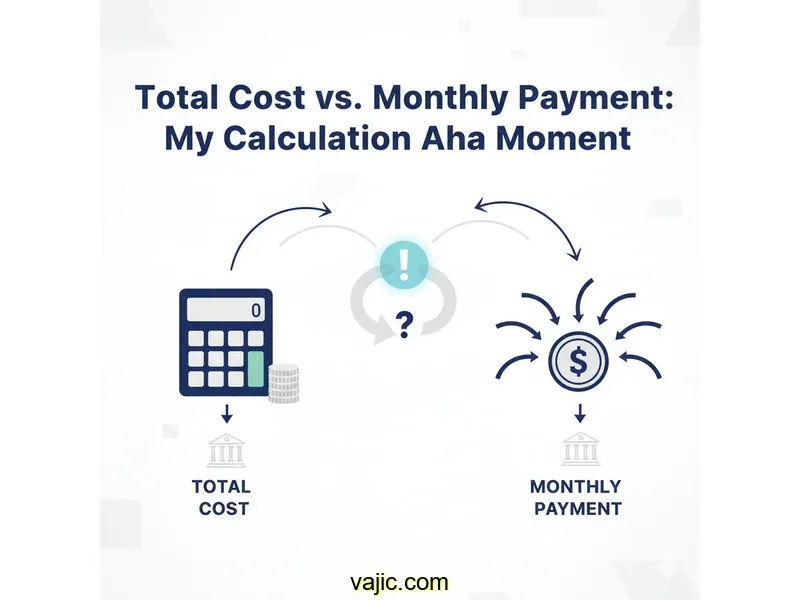
Auto Loan Calculator
Calculate payments over the life of your Loan
Home Blog Privacy Terms About Contact
Calculate payments over the life of your Loan
Home Blog Privacy Terms About ContactPublished on October 13, 2025

It all started with a simple question that I couldn't shake. I was playing around with some online loan calculators, just out of curiosity, trying to understand how all the numbers fit together. I set up two hypothetical scenarios for the same loan amount. Scenario A had a low monthly payment but stretched out for five years. Scenario B had a noticeably higher monthly payment but was finished in four years.
My brain, trained to think about my monthly budget, immediately focused on Scenario A. "Lower payment means it's cheaper, right?" I thought. It seemed so obvious. A lower number leaving my bank account each month felt like a win. But a nagging feeling told me I was missing a huge piece of the puzzle. How could paying less each month possibly end up costing more? What was the invisible math happening behind the scenes?
This wasn't about making a financial decision; for me, it was about a fundamental lack of understanding. I realized I didn't truly grasp the relationship between time, interest, and money. My goal became simple: I wanted to understand the mechanics behind the numbers. I wanted to be able to explain to myself, with confidence, exactly why two loans for the same amount could have such drastically different total costs. My journey into the world of loan calculators began not with a need for a loan, but with a deep-seated need for clarity.
I want to be clear from the start: This article is about my journey to understand how these calculations work and how to use the tools available online. It's about building financial literacy, not giving financial advice. My "aha" moments are about the math, and I hope sharing them can help demystify these concepts for others too.
My initial approach was, in hindsight, incredibly simplistic. I put a hypothetical loan amount of $13,850 into a calculator. For my first scenario, I set the term to 60 months (5 years) at a 7.4% interest rate. The calculator spit out a monthly payment of about $277.63. For the second scenario, I kept the loan amount and interest rate the same but changed the term to 48 months (4 years). The monthly payment jumped to $332.32.
I did what I thought was logical. I subtracted the two monthly payments: $332.32 - $277.63 = $54.69. My conclusion was that the 60-month option "saved" me nearly $55 every single month. In my mind, this was the end of the story. The numbers were right there in front of me, and one was clearly smaller than the other. I felt like I had solved the puzzle and the answer was to always pick the lower payment.
The frustration began when I looked closer at the calculator's results summary. There were other fields I had been completely ignoring: "Total Principal Paid," "Total Interest Paid," and "Total of all Payments." My eyes scanned down to the "Total Interest Paid" line. For the 60-month loan, it showed $2,807.80. For the 48-month loan, it was $2,101.36. I stared at the screen, completely baffled. My "cheaper" option was going to cost me over $700 more in interest. How could that be possible?
My simple subtraction was a dangerous oversimplification. I had focused on a single data point—the monthly payment—while ignoring the context that gave it meaning. The calculator was telling me a completely different story than the one I had constructed in my head. It wasn't that the calculator was wrong; it was that my understanding of how to interpret its results was fundamentally flawed. I knew then that I had to dig deeper and understand the engine running under the hood, not just the numbers on the dashboard.
This confusion became my motivation. I decided to stop looking for a quick answer and instead focus on understanding the process. I didn't close the calculator; I started using it as a learning tool. My breakthrough came not from reading a complicated formula, but from systematically changing one input at a time and watching how all the other numbers reacted. I left the loan amount ($13,850) and interest rate (7.4%) locked in and focused solely on the "Loan Term" input. As I dragged the slider from 60 months down to 48, then to 36, I saw the direct relationship: as the term got shorter, the monthly payment went up, but the total interest paid plummeted. It was like watching a seesaw—one side went up while the other went down. That visual connection was my "aha" moment. Time wasn't just a deadline for payments; it was the fuel for interest. Less time meant less fuel.
My first big learning step was to treat the calculator like a science experiment. To understand the effect of the loan term, I had to keep everything else constant. By locking in the $13,850 loan amount and the 7.4% interest rate, I knew that any change I saw in the output was caused *only* by my adjustments to the term. This simple method of isolating variables allowed me to see clear cause-and-effect relationships within the loan calculation.
My second discovery was to shift my focus. I stopped looking at the "Monthly Payment" as the primary answer. Instead, I started treating the "Total Interest Paid" as the real metric of cost. The monthly payment simply tells you how much you need to budget for each month. The total interest tells you how much the service of borrowing the money is actually costing you over time. Once I made that mental shift, comparing loans became incredibly clear.
The final piece of the puzzle clicked into place when I opened the "View Amortization Schedule" link on the calculator. For the 60-month loan, I saw that the very first payment of $277.63 only reduced my loan principal by $192.38. A whopping $85.25 went just to interest! In contrast, the first payment on the 48-month loan, while higher at $332.32, put $247.07 toward the principal. Seeing this breakdown, month by month, made it tangible. The longer loan was "interest-heavy" at the start, which is exactly why the total interest accumulated to a much higher number over time.
To confirm my new understanding, I ran a completely different simulation. I imagined a $21,500 loan at a 6.8% rate. I compared a 36-month term to a 72-month term. The results were even more dramatic, but the principle was identical. The much lower monthly payment of the 72-month term came at the cost of thousands more in total interest. I had cracked my own code.
Going through this process of confusion and discovery taught me a few fundamental lessons about reading and interpreting loan calculations. These aren't rules about what financial choices to make, but rather a personal guide for how to understand the numbers and use the tools effectively. It's about building calculation literacy, one step at a time.

During my learning process, I kept asking myself the same questions over and over until I found answers that made sense. Here are some of the key questions that helped me build my understanding.
This was the core of my confusion. The answer is time. A lower monthly payment is usually achieved by extending the loan's term (the number of months you have to pay it back). While this makes each individual payment smaller, it gives the lender more months to charge interest on your remaining balance. This can lead to you paying significantly more in total interest over the life of the loan.
From my experience, the two most powerful fields for comparison are "Total Interest Paid" and "Total of all Payments." The "Total Interest Paid" shows you the raw cost of borrowing. The "Total of all Payments" shows you the entire amount of money that will leave your bank account by the end of the loan. Looking at these two numbers side-by-side provides a much clearer picture of the overall financial impact than just looking at the monthly payment.
The loan term has a huge effect. A longer term reduces your monthly payment but increases the total interest you pay. A shorter term increases your monthly payment but reduces the total interest you pay. Each payment you make has two parts: principal (the money you borrowed) and interest (the cost of borrowing). With a longer term, more of your early payments are allocated to interest, slowing down how quickly you reduce the principal. Because your principal balance stays higher for longer, more interest accumulates over time.
An amortization schedule is a detailed, month-by-month table showing how each of your payments is broken down. It's an incredibly educational tool. It clearly lists how much of each specific payment goes toward interest and how much goes toward reducing your principal balance. You can visually see how, in the beginning, the interest portion is high, and as time goes on, the principal portion grows. It's the ultimate proof of how a loan's balance is paid down over time.
My journey started with a simple point of confusion: why the "cheaper" monthly payment was actually the more expensive option. What I gained was not an answer about which loan to choose, but a much deeper understanding of the mechanics of borrowing. My biggest takeaway is that the monthly payment and the total cost tell two completely different, though equally important, stories about a loan.
The monthly payment tells a story about affordability and its impact on your immediate budget. The total cost tells a story about the long-term financial reality and the true price of borrowing money. Learning to read and understand both stories is the essence of what I feel financial literacy is all about. It's about moving from a surface-level view to a comprehensive understanding.
I genuinely encourage anyone who feels intimidated by these numbers to open an online calculator and just play. Change the numbers, ask "what if," and watch how the outputs change. You're not making a commitment; you're educating yourself. Building that confidence in how the calculations work is a powerful step toward navigating personal finance with more clarity. It certainly was for me.
This article is about understanding calculations and using tools. For financial decisions, always consult a qualified financial professional.
Disclaimer: This article documents my personal journey learning about loan calculations and how to use financial calculators. This is educational content about understanding math and using tools—not financial advice. Actual loan terms, rates, and costs vary based on individual circumstances, creditworthiness, and lender policies. Calculator results are estimates for educational purposes. Always verify calculations with your lender and consult a qualified financial advisor before making any financial decisions.
About the Author: Written by Alex, someone who spent considerable time learning to understand personal finance calculations and use online financial tools effectively. I'm not a financial advisor, accountant, or loan officer—just someone passionate about financial literacy and helping others understand how the math works. This content is for educational purposes only.